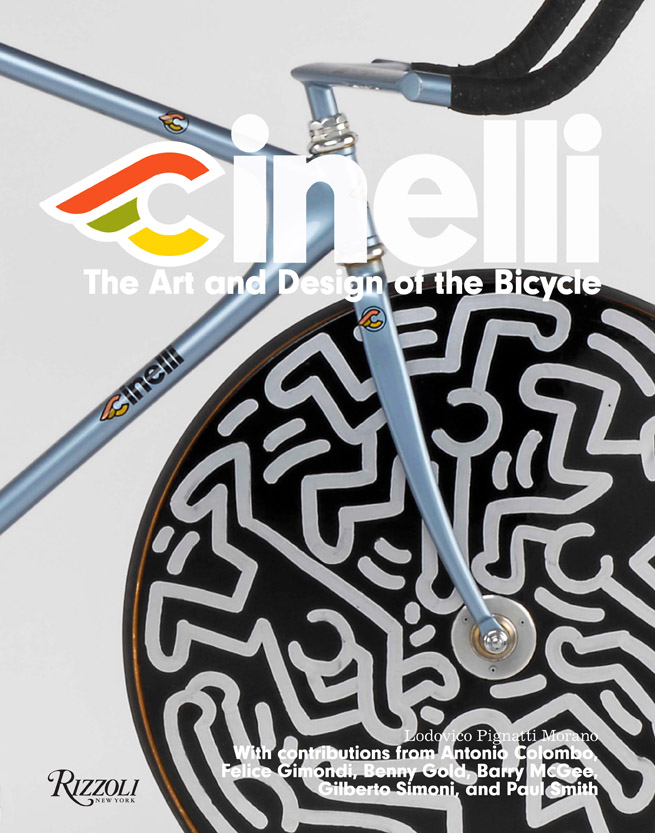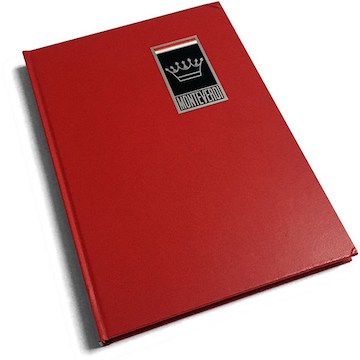Bagheera: l’irrésistible panthère de Matra Simca
 by André Dewael
by André Dewael
[Cher lecteur, la traduction française de cette critique se trouve en bas de la page.]
(French) Author André Dewael founded the Belgian Matra Club in 1987 and so it is quite natural that he embarked on the huge task of writing the definitive book on the futuristic Bagheera coupé. Matra stands for “Mécanique, aviation, traction”—an innocuous name for an engineering company that made weapons and missiles! When the firm wanted to soften its image it went into automobile production (with automaker Simca) with a winning combination: Jean-Luc Lagardère as managing director and Philippe Guédon, the visionary and genial engineer who was to create the 3-seater coupé, the Renault Espace and later the Avantime.
This book could have been entitled “All you’ve always wanted to know about the Bagheera” because no stone was left unturned. The author goes into great detail, from the conception of the prototypes until the end of the Bagheera venture in 1980. The story starts with Jean-Luc Lagardère’s program for the 1960s: enter a car in Formula 3, then in Formula 2 and Formula 1, and win Le Mans. No small order! This would be enough to establish a sporty image to help with the launch and sales of a coupé aimed at the general public. Thus the Matra 530 was born but its unorthodox looks didn’t make much of an impact on the general public and it was a commercial flop. The Bagheera was to change all that because a radical approach was used in its concept: the car was designed from the inside out. The starting point was a three-across front seating arrangement instead of two seats in front and two cramped, uncomfortable seats in the back. This normally wasted space would allow for a rear-mounted engine ahead of a spacious trunk. The lines of the coachwork were inspired by Italian designs and the result was so pleasing that the model sold to the tune of almost 48,000 copies. Not bad at all considering that France is not a “sports car country” of the hand-made variety.
The first chapters deal with the genesis of the prototypes and the tests in various countries. The author was very lucky to be helped by both Philippe Guédon, the father of the Bagheera and by Roger Charbonnel, the test driver, who made many private photographs available. The car was presented to the press at Le Mans in June 1973: 520 yellow Bagheeras were parked outside the circuit for all Matra-Chrysler dealers to test drive and take one back home! Quite a number of them paraded as a pack of wolves around the circuit in front of the world’s TV cameras just before the race started. Icing on the cake, a Matra 670B won the race 24 hours later!
The next chapters retrace the evolution of the car over the six years of its lifespan and its specifications, with particular mention of the exclusive Courrèges limited edition. Courrèges was a French fashion designer who had a passion for the color white. Therefore, the Matra Courrèges was all-white, inside and out, with only a bit of tan gold trim to the dashboard and door panels to break the uniformity. Towards the end of its run, the Bagheera was available in S and X versions, presumably to boost sales.
The book contains several tables that show all the variants of the model and the various color schemes including paint and cloth codes, special equipment, etc. Very useful if you want to restore a car. A short chapter is dedicated to rallying Bagheeras and the penultimate chapter describes the transition from Bagheera to Murena, the next Matra model.
The last chapter is of particular interest to all those who want to buy and/or restore a Bagheera. A lot of photographs illustrate what areas must not be overlooked and show what kind of work is required to carry out a proper restoration. Addresses of clubs, specialists and spare parts sources (all in Europe) are also given at the end of the book along with a short Bibliography. Unfortunately, there is no Index and the graphic layout/design is desperately old-fashioned. In addition to the photos there are several coachwork and technical drawings and also a cutaway. The photo quality is rather inconsistent. The occasional roadside snapshot taken with an amateur camera is acceptable when they are printed in small size because they do serve a purpose as documentary slices of history, but here there are several spreads that are definitely not crisp enough for use at the 16 x 11 inch (when open) size. These are my only regrets.
This is an exhaustive work of labor and passion about a car which was itself a work of labor and passion, and I can’t imagine someone could own a Bagheera and not have a copy of this book on the shelf. But the book is also interesting if you want to learn how it was possible to make a successful car out of the blue, or if you want to see the birth of a car from behind the curtains, as if you too were one of Philippe Guédon’s “wild bunch of engineers.”
Copyright 2011, André Blaize (speedreaders.info).
Bagheera, l’irrésistible panthère de Matra Simca
by André Dewael
Editions ETAI, 2010
160 pages, 283 color & b/w photos, hardcover
List Price: €39
ISBN 13: 978-2 7268 8986 2
[Below please find the French version of this review]
André Dewael a fondé le Belgian Matra Club en 1987 et il est tout naturel qu’il se soit embarqué dans l’écriture du livre de référence sur ce coupé futuriste.
Matra est l’acronyme de « Mécanique, aviation, traction », un nom bien doux pour un fabricant d’armes et de missiles ! Lorsque la firme voulut donner une image de marque plus positive, elle se lança dans l’aventure automobile à l’aide d’un duo gagnant: Jean-Luc Lagardère à la direction et Philippe Guédon, l’ingénieur visionnaire et génial qui devait créer ce coupé trois places, puis le Renault Espace et, plus tard, l’Avantime.
Ce livre aurait pu s’intituler « Tout ce que vous avez toujours voulu savoir sur la Bagheera » car aucun aspect n’est laissé dans l’ombre. L’auteur fouille l’histoire dans ses moindres détails, depuis la conception des prototypes jusqu’à la fin de l’aventure Bagheera.
L’histoire commence avec le programme établi par Jean-Luc Lagardère pour les années 60 : faire participer une voiture au championnat de Formule 3, puis de Formule 2, de Formule 1 et gagner Le Mans… rien de moins ! Ceci devait être suffisant pour donner à la marque une image sportive qui lancerait le modèle grand public et favoriserait les ventes. C’est ainsi que naquit la Matra 530, mais sa ligne peu conventionnelle freina les ventes et ce fut un échec commercial. La Bagheera allait changer la donne parce qu’elle était le fruit d’une approche radicalement opposée; la voiture fut conçue de l’intérieur vers l’extérieur : le concept était « 3 places à l’avant », au lieu de 2 places à l’avant et deux mini-sièges inconfortables à l’arrière. Cet espace habituellement perdu allait permettre d’installer le moteur transversalement et d’offrir un coffre de capacité acceptable. Les lignes de la voiture étaient inspirées des meilleurs carrossiers italiens et le résultat fut si réussi que la Bagheera se vendit à près de 48000 exemplaires. Pas mal du tout car la France est loin d’être un pays à voitures de sport, même fabriquées à la main sans aucune intervention de robots.
Les premiers chapitres portent sur la conception des prototypes et les essais dans divers pays. L’auteur a eu la chance d’être aidé à la fois par Philippe Guédon, le père de la Bagheera et par Roger Charbonnel, le pilote d’essais, qui a apporté bon nombre de photos privées.
La voiture fut présentée à la Presse au Mans en Juin 1973: 520 Bagheera jaunes furent exposées à l’écart du circuit pour que tous les concessionnaires Matra-Chrysler puissent les essayer et éventuellement en ramener une chez eux ! Un certain nombre d’entre elles regroupées en meute fit un tour de circuit devant les caméras du monde entier en lever de rideau de l’épreuve la plus célèbre. Cerise sur le gâteau, une Matra 670B allait gagner la course 24 heures plus tard.
Les chapitres suivants retracent l’évolution de la voiture pendant les 6 années de sa vie, ainsi que ses caractéristiques, avec une mention particulière pour la version « Courrèges ». Courrèges était un couturier dont la marque de fabrique était la couleur blanche. Donc la Matra Courrèges était entièrement blanche dehors et dedans, à l’exception du tableau de bord et des contre-portes qui étaient havane doré pour rompre l’uniformité. A la fin de sa production, la Bagheera fut déclinée en versions S et X, sans doute pour stimuler les ventes.
Un chapitre plus court est dédié aux Matra utilisées en rallyes et l’avant dernier chapitre aborde la transition entre la Bagheera et le modèle suivant, la Murena.
Le dernier chapitre est particulièrement intéressant pour tous ceux qui veulent acheter et/ou restaurer une Bagheera. De nombreuses photos illustrent les endroits pour lesquels il faut être vigilant et montrent le genre de travaux qu’il faut envisager pour entreprendre une restauration de qualité. Les adresses des clubs, des spécialistes et des sources de pièces détachées sont également fournies à la fin de l’ouvrage.
Malheureusement il n’y a pas d’index et la conception graphique est désespérément vieillotte, tant dans la mise en page que dans le choix des couleurs. Certaines photos amateurs prises sur le bord de la route sont acceptables en tant que témoignages car elles sont de petite taille mais certaines photos artistiques ne sont pas assez piquées pour être imprimées en 28 cm x 43 cm. Ce sont là mes seuls regrets.
En conclusion, nous avons ici le résultat d’un travail de passion sur une voiture qui était, elle aussi, un travail de passion et je ne peux pas imaginer qu’un propriétaire de Bagheera n’ait pas un exemplaire de ce livre dans sa bibliothèque. Ce livre est également intéressant si vous voulez découvrir comment il est possible créer une voiture à succès à partir de presque rien ou bien si vous voulez assister à la conception d’une voiture comme si vous étiez en coulisses, comme un des ingénieurs de la « bande à Guédon ».


 RSS Feed - Comments
RSS Feed - Comments






































































 Phone / Mail / Email
Phone / Mail / Email RSS Feed
RSS Feed Facebook
Facebook Twitter
Twitter